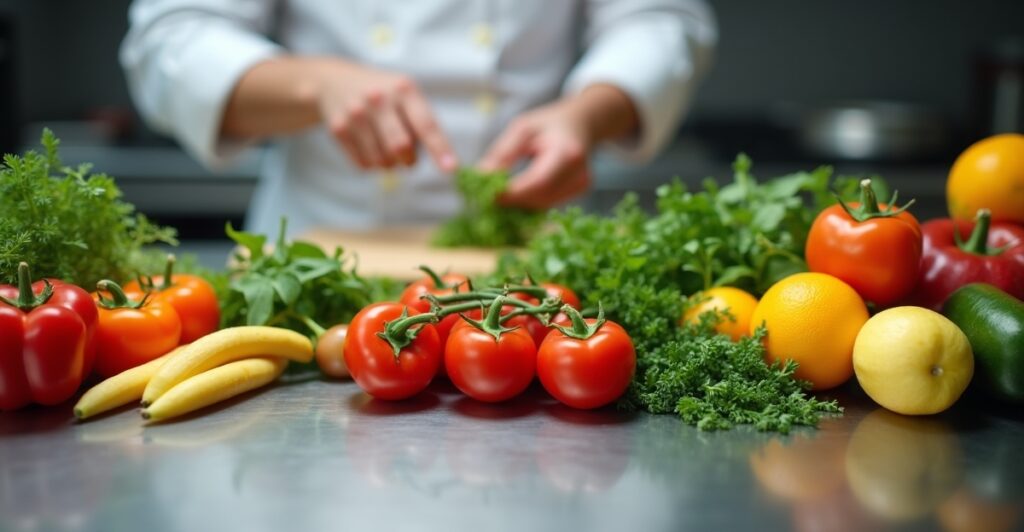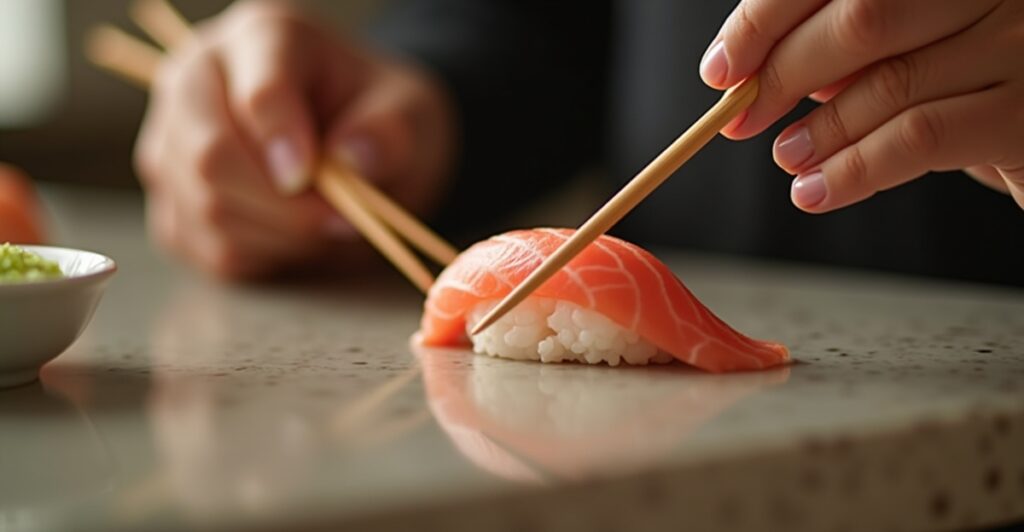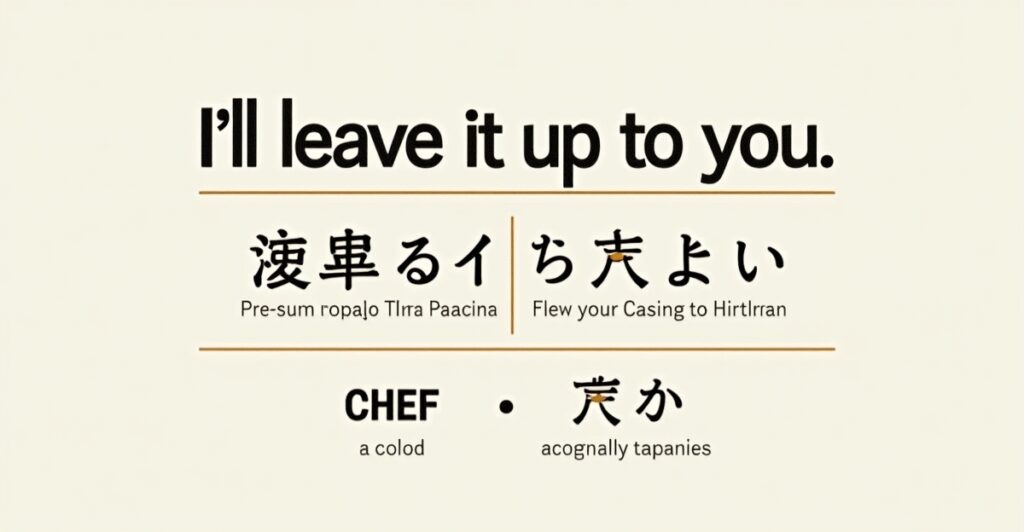Omakase (お任せ) is a Japanese dining experience where diners place complete trust in the chef’s expertise, literally meaning “I’ll leave it up to you.” This unique culinary journey transcends traditional restaurant dining, creating an intimate performance where master chefs craft personalized tasting menus using the finest seasonal ingredients available.
Far more than simply ordering off a menu, omakase represents a profound cultural exchange between chef and diner. It’s an art form where culinary mastery meets seasonal poetry, where each bite tells a story of tradition, technique, and the chef’s creative vision. This immersive fine dining experience transforms a meal into a carefully orchestrated culinary journey, making omakase the ultimate chef’s table experience for discerning food enthusiasts.
What is Omakase? More Than Just a Meal, It’s a Philosophy
The Literal Meaning: Omakase derives from the Japanese verb “makaseru,” meaning “to entrust.” When you choose omakase, you’re not merely selecting a meal—you’re entering into a sacred trust with the chef, surrendering control of your dining destiny to their expertise and creative vision.
This Japanese culinary philosophy represents a departure from Western dining conventions. Rather than exercising control through menu selection, diners embrace the unknown, allowing the chef’s intuition and seasonal ingredients to guide the experience. The chef becomes both artist and curator, crafting a unique narrative that unfolds with each carefully timed course.
The beauty of omakase lies in its emphasis on seasonality and trust. Master chefs select ingredients at their peak freshness, often sourcing directly from trusted suppliers or markets that morning. This commitment to seasonal ingredients means no two omakase experiences are identical—each meal captures a specific moment in time, reflecting the chef’s interpretation of what nature offers that day.
The Philosophy of “I’ll Leave It Up To You” (お任せ)
The cultural significance of omakase extends far beyond culinary boundaries, embodying fundamental Japanese values of respect, trust, and mastery. When diners utter “omakase,” they acknowledge the chef’s years of training, their intimate knowledge of ingredients, and their ability to create harmonious flavor progressions.
This trust-based relationship reflects the Japanese concept of “shokunin”—the craftsperson’s spirit of dedication to perfecting one’s craft. In omakase, the chef’s discretion becomes paramount. They consider not only the quality of available ingredients but also subtle cues from diners: their pace of eating, apparent preferences, and even non-verbal reactions to previous courses.
The historical evolution of omakase can be traced back to Japan’s traditional dining culture, where relationships between artisans and patrons were built on mutual respect and understanding. Master chefs would gradually learn their regular customers’ preferences, creating increasingly personalized experiences. This intimate knowledge allowed for subtle customization while maintaining the element of surprise that makes omakase so compelling.
Omakase Beyond Sushi: Exploring Other Culinary Traditions
While sushi omakase has gained international recognition, this dining philosophy extends across various Japanese fine dining styles. Tempura omakase features master chefs preparing delicate, crispy tempura in real-time, adjusting batter consistency and oil temperature for each ingredient. The chef’s expertise determines the precise moment when each piece reaches perfection.
Kaiseki represents perhaps the most formal expression of omakase principles, where chefs create elaborate multi-course meals following seasonal themes and traditional presentation styles. For those interested in understanding the intricate sequence of a traditional Japanese meal, kaiseki offers a window into Japan’s most refined dining traditions.
Kappo, meaning “to cut and cook,” provides a more intimate omakase experience where diners observe the chef’s knife work and cooking techniques throughout the meal. These diverse Japanese fine dining styles share omakase’s core philosophy: trusting the chef’s expertise to create memorable culinary experiences that celebrate seasonal ingredients and traditional techniques.
The Unspoken Symphony: Chef, Diner, and the Artistry
The relationship between chef (itamae) and diner forms the heart of every omakase experience. This dynamic extends beyond typical service relationships, creating an intimate culinary performance where both parties play essential roles. The chef serves as conductor, orchestrating timing, flavors, and presentations, while diners provide subtle feedback through their engagement and appreciation.
This culinary narrative unfolds through careful observation and unspoken communication. Experienced itamae read their diners’ responses, adjusting subsequent courses based on observed preferences or dietary restrictions. The art of sushi, particularly in Edomae style preparations, requires split-second timing—serving each piece at optimal temperature when the seasoned rice achieves perfect texture.
The Chef’s Vision: Curating a Culinary Narrative
Master chefs approach omakase with the mindset of storytellers, crafting progression of courses that build upon each other like chapters in a book. The chef’s selection process begins hours before service, evaluating available ingredients for quality, seasonality, and how they’ll complement the evening’s planned narrative.
As a master sushi chef might explain, “Each piece tells a story, a fleeting moment of the season.” This philosophy guides ingredient selection and preparation techniques. Seasonal ingredients drive menu decisions—spring might feature tender bamboo shoots and sweet shrimp, while autumn brings rich uni and delicate chrysanthemum petals.
The Edomae style of sushi preparation exemplifies this narrative approach. Chefs consider not only individual ingredients but also how their flavors, textures, and temperatures will interact throughout the meal. Lighter, more delicate flavors typically appear early, gradually building toward richer, more intense preparations that showcase the chef’s technical mastery.

The Diner’s Role: Active Appreciation and Respect
Contrary to passive dining experiences, omakase requires active appreciation and respect from diners. Your role extends beyond consumption to becoming an engaged participant in the culinary narrative. Observing the chef’s techniques, appreciating subtle details, and providing thoughtful responses enhance the overall experience for everyone involved.
Sensory engagement becomes crucial during omakase. Notice the temperature of rice against your palate—properly seasoned shari should feel slightly warm, complementing the fish’s temperature. Observe how different neta (toppings) provide varying textures, from the buttery richness of otoro to the firm snap of kohada. The subtle cues you provide through your interaction with chef help guide the meal’s direction.
Respectful interaction with the chef demonstrates appreciation for their craft. Simple acknowledgments like “oishii” (delicious) or subtle nods of approval provide valuable feedback. Avoid overwhelming the chef with excessive conversation during busy preparation moments, but don’t hesitate to express genuine curiosity about techniques or ingredients when appropriate.
Mastering the Omakase Experience: Etiquette and Expectations
Understanding proper omakase etiquette elevates both your enjoyment and the chef’s ability to provide exceptional service. Japanese dining etiquette emphasizes respect, mindfulness, and appreciation for the craftsmanship involved. Following these fine dining rules ensures a smooth experience while honoring the cultural significance of what to expect at omakase.
The intimate nature of omakase dining requires heightened awareness of your behavior’s impact on other diners and the chef’s concentration. Unlike casual dining, every action contributes to the collective atmosphere, making proper preparation and conduct essential for everyone’s enjoyment.
Before You Arrive: Preparation is Key
Booking omakase requires advance planning, often weeks or months ahead for renowned establishments. When making reservations, clearly communicate any dietary restrictions or allergies. Most high-end omakase restaurants prefer advance notice rather than last-minute requests that might disrupt the chef’s planned progression.
Dress code expectations vary by establishment, but err toward business casual or smart casual attire. Avoid heavy perfumes or colognes that might interfere with the subtle aromas of your meal or disturb other diners’ sensory experience. This consideration demonstrates respect for both the chef’s artistry and fellow diners’ enjoyment.
Punctuality cannot be overstated in Japanese culture. Arrive exactly on time—neither early nor late. Omakase timing is carefully orchestrated, and delays can disrupt the entire evening’s service. Many restaurants have strict policies regarding late arrivals, potentially forfeiting your reservation and payment.
Consider eating lightly beforehand, as omakase meals can be substantial. However, arrive with a genuine appetite to fully appreciate each course. Some establishments provide preliminary information about the evening’s theme or featured ingredients, allowing you to mentally prepare for the experience ahead.
At the Counter: Navigating the Subtle Cues
How to eat sushi properly during omakase differs from casual sushi consumption. Use your hands or chopsticks based on the establishment’s custom—when in doubt, observe other diners or ask politely. Eat each piece in one bite when possible, savoring the harmony of flavors the chef intended.
Chopstick etiquette becomes particularly important in close quarters. For detailed guidance on avoiding common chopstick mistakes, proper technique shows respect for Japanese customs. Never pass food between chopsticks, point with them, or leave them standing upright in rice.
Interacting with chef requires reading social cues carefully. Engage when the chef seems receptive—often during brief lulls between preparations. Ask thoughtful questions about techniques or ingredients, but avoid interrupting during concentrated work. Your genuine interest in their craft is usually welcomed and appreciated.
Tipping in Japan including omakase situations, differs significantly from Western customs. Tipping is generally not expected and can sometimes cause confusion or offense. The service charge, if any, is included in your bill. Express appreciation through words, respectful behavior, and return visits rather than monetary tips.

Understanding Value: Why Omakase Commands its Price
Omakase price reflects multiple factors beyond ingredient costs. Why is omakase expensive? The answer lies in the intersection of quality ingredients, chef’s skill, and exclusivity that defines this dining experience. Understanding these components helps appreciate the investment required for authentic omakase.
Premium ingredients form the foundation of omakase value. Wild-caught fish, often sourced directly from Japan’s premier markets, commands significantly higher prices than farmed alternatives. Seasonal vegetables, artisanal soy sauces, and aged vinegars each contribute to elevated costs while ensuring exceptional quality throughout the meal.
The chef’s expertise represents years of dedicated training and continuous refinement. Master sushi chefs often apprentice for decades before achieving independence. This accumulated knowledge—understanding fish aging, rice seasoning, knife techniques, and flavor pairing—justifies the premium pricing of their services.
Exclusivity and intimacy further enhance omakase value. Limited seating ensures personalized attention and creates scarcity that commands higher prices. The time investment required—both in preparation and service—means chefs can serve fewer customers while providing more intensive experiences than conventional restaurants.
Enhancing Your Omakase Journey
Deepening your appreciation for omakase requires cultivating mindfulness and cultural understanding beyond basic etiquette. This sensory experience rewards diners who engage thoughtfully with each element, from subtle flavor progressions to the aesthetic presentation that characterizes Japanese food culture.
Developing your palate and cultural knowledge transforms omakase from mere consumption into genuine appreciation of culinary artistry. This enhanced awareness amplifies enjoyment while demonstrating respect for the traditions and techniques that make omakase extraordinary.
Sensory Mindfulness: Engaging All Your Senses
Sensory appreciation begins before the first bite touches your palate. Observe the visual artistry—how the chef’s knife work creates precise cuts that enhance both appearance and texture. Notice the texture of sushi rice: properly prepared shari should feel slightly warm and maintain its shape without being too firm or too loose.
Mindfulness in dining extends to aromatic experiences. Inhale gently before eating, appreciating how different fish and preparations offer distinct aromas. The aroma of sake, if you choose to pair it with your meal, should complement rather than overpower the subtle flavors of each course.
Pay attention to temperature contrasts—how cool fish interacts with warm rice, or how different preparations affect mouthfeel. The way ingredients dissolve on your tongue, the balance of umami flavors, and the progression from lighter to richer tastes all contribute to the complete sensory experience the chef has orchestrated.
Silence between bites allows full appreciation of lingering flavors and prepares your palate for the next course. This mindful approach enhances both your personal enjoyment and your ability to engage meaningfully with the chef’s artistic vision.
Key Japanese Vocabulary for the Omakase Table
Japanese food terms enhance understanding and demonstrate respect for the cultural context of your meal. Sushi vocabulary goes beyond basic terms, encompassing the nuanced language that describes techniques, ingredients, and preparations specific to omakase dining.
Essential omakase terminology:
• Itamae (板前) – The master chef, literally “in front of the cutting board”
• Nigiri (握り) – Hand-pressed sushi rice topped with fish or seafood
• Neta (ネタ) – The fish or topping placed on sushi rice
• Shari (シャリ) – Seasoned sushi rice, the foundation of every piece
• Shun (旬) – Peak season for ingredients, when they’re at optimal quality
• Omakase (お任せ) – “I leave it up to you,” the core philosophy of trust-based dining
Understanding these terms allows for more meaningful interaction with the chef and demonstrates your appreciation for Japanese culinary traditions. When you can distinguish between different types of preparations or recognize seasonal specialties, you become a more engaged participant in the omakase experience.

Frequently Asked Questions About Omakase
Is omakase only sushi? No, while sushi omakase is the most internationally recognized form, omakase philosophy extends to various Japanese dining styles including tempura, kaiseki, and kappo. The core principle—trusting the chef’s expertise and seasonal ingredient selection—applies across different culinary traditions.
How much does omakase cost? Omakase prices vary significantly based on location, restaurant reputation, and ingredient quality. Expect to pay premium prices reflecting the exclusive nature of the experience, typically ranging from moderate to very expensive depending on the establishment’s caliber and the chef’s reputation.
What’s the difference between omakase vs a la carte? Omakase removes menu choice from the diner, allowing the chef to create a personalized progression of courses based on seasonal availability and their expertise. A la carte dining provides menu selection but lacks the narrative flow and seasonal adaptation that characterizes omakase experiences.
Do you tip at omakase? Tipping is not customary in Japan and is generally unnecessary at omakase restaurants. Show appreciation through respectful behavior, genuine engagement with the experience, and verbal acknowledgment of the chef’s skill rather than monetary gratuities.
How long does omakase take? Most omakase experiences last 90 minutes to 2 hours, depending on the number of courses and the establishment’s pacing. The chef controls timing to ensure optimal temperature and texture for each course, so allow sufficient time without rushing.
Can I make special requests during omakase? While omakase emphasizes chef’s discretion, most chefs accommodate dietary restrictions or allergies when informed in advance. Avoid making requests that contradict the omakase philosophy—trust the chef’s selections while communicating genuine limitations respectfully.
Conclusion: Embracing the Omakase Philosophy
The art of omakase transcends dining to become a meditation on trust, seasonality, and culinary mastery. This authentic Japanese experience invites you to surrender control and embrace the unknown, discovering flavors and preparations you might never have chosen independently. Through this trust-based relationship with master chefs, diners gain access to culinary artistry that celebrates both tradition and innovation.
Understanding omakase philosophy enriches every aspect of the experience—from the respectful silence that allows appreciation of subtle flavors to the seasonal poetry expressed through ingredient selection. Each omakase meal becomes a unique chapter in your culinary education, expanding your palate while honoring centuries-old Japanese traditions.
As you embark on your own omakase journey, remember that this culinary art form rewards mindfulness, respect, and genuine curiosity. Approach each experience with an open mind and heart, ready to discover the extraordinary artistry that emerges when master craftsmanship meets seasonal perfection. The memories created during these intimate culinary performances will long outlast the final bite, leaving you with deeper appreciation for the dedication and skill that transforms simple ingredients into transcendent dining experiences.

